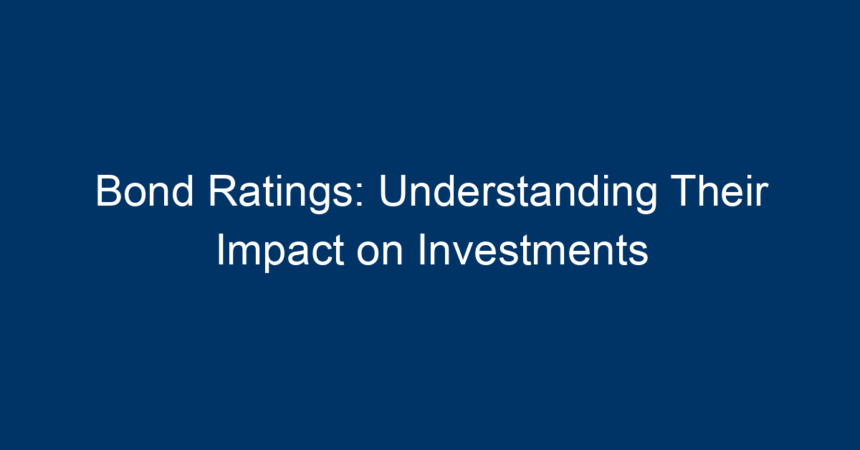Investing in bonds can be a critical component of a well-balanced portfolio, but understanding the intricacies of bond ratings is essential for making informed decisions. Bond ratings provide investors with valuable insights into the creditworthiness of issuers, helping to assess the risks associated with specific bonds. In this article, we will delve into the world of bond ratings, explain how they work, and illustrate their significance in the context of investment strategies.
What Are Bond Ratings?
Bond ratings are evaluations of the credit quality of debt securities, typically issued by independent rating agencies such as Standard & Poor’s (S&P), Moody’s, and Fitch Ratings. These ratings help investors gauge the risk of default and the likelihood that the issuer will fulfill its debt obligations.
The Rating Scale
Bond ratings are expressed through a letter-based scale ranging from the highest quality, such as AAA, to lower quality, which can include grades like B or C. Here’s a brief overview of the most common ratings:
- AAA (Aaa): Highest quality, low risk of default.
- AA (Aa): Very high quality, low risk.
- A: Strong capacity to meet obligations, but somewhat more susceptible to adverse economic conditions.
- BBB (Baa): Medium-grade securities, adequate capacity to pay, but more vulnerable to economic downturns.
- BB (Ba) and lower: Speculative, with increasing risk of default.
Understanding this hierarchy is crucial for investors considering long-term investment strategies.
Why Bond Ratings Matter
Bond ratings play a pivotal role in the investment landscape for several reasons:
1. Risk Assessment
One of the primary functions of bond ratings is to assist in assessing risk. A higher rating typically signifies lower risk, making such bonds more attractive to conservative investors. Conversely, lower-rated bonds may offer higher yields but come with increased default risk. Thus, understanding bond ratings can help investors align their risk tolerance with their investment choices.
2. Interest Rates and Yields
Bond ratings directly influence interest rates and yields. Issuers with higher ratings can borrow at lower interest rates, as investors view their bonds as safer investments. In contrast, lower-rated bonds must offer higher yields to entice investors offset by higher risk. This relationship reinforces the importance of understanding bond ratings when selecting investments.
3. Portfolio Diversification
For savvy investors, bond ratings offer opportunities for diversification. Including a mix of bonds with varying ratings can help balance risk and yield within an investment portfolio. This can be particularly valuable during periods of market volatility.
How Bond Ratings Are Assigned
The process of assigning bond ratings is meticulous, involving comprehensive analyses of various factors. Rating agencies consider the following:
1. Financial Health of the Issuer
Key indicators of an issuer’s financial health include debt levels, revenue streams, profitability, and economic outlook. Agencies thoroughly scrutinize these factors to determine the issuer’s ability to meet its debt obligations.
2. Economic Environment
The broader economic environment significantly impacts credit ratings. Fluctuations in interest rates, inflation, and overall economic growth can influence the capacity of issuers to repay their debts.
3. Industry Trends
Specific industries may face unique challenges that could impact an issuer’s financial stability. Rating agencies consider how industry trends may affect revenue and, consequently, debt repayment capabilities.
The Impact of Bond Ratings on Investment Strategies
1. Investment Selection
Investors often use bond ratings to filter their investment options. For example, a conservative investor may focus on AAA-rated bonds, while those seeking higher returns may explore lower-rated bonds, accepting the higher risk involved.
2. Bond Funds vs. Individual Bonds
Investors can choose between investing in individual bonds or bond mutual funds. Bond ratings are particularly valuable in assessing bond funds, where a diversified mix of bonds is managed collectively. Understanding the average ratings of the underlying securities can help investors gauge the fund’s risk profile.
3. Monitoring Market Conditions
Market dynamics and re-evaluation of ratings can create buying opportunities. For instance, if a bond’s rating is downgraded due to economic downturns, its price may decline, potentially presenting a buying opportunity for value-oriented investors.
4. Regulatory Considerations
Institutional investors, such as pension funds and insurance companies, often face regulatory requirements dictating the minimum credit quality of the bonds they can hold. Understanding bond ratings is crucial for these entities to ensure compliance.
Misconceptions About Bond Ratings
Despite their importance, bond ratings come with misconceptions that investors should be aware of:
1. Ratings Are Absolute Guarantees
It’s important to understand that bond ratings are opinions, not guarantees. Even bonds with high ratings can default under unforeseen circumstances. Thus, investors should conduct their assessments and not rely solely on ratings.
2. Ratings Change
Bond ratings are not static; they can change over time. Regular monitoring of rating changes is vital as downgrades may indicate increased risk, whereas upgrades can signal improved creditworthiness.
3. All Ratings Agencies Are Alike
Not all rating agencies use the same methodologies. While S&P, Moody’s, and Fitch are the most recognized, each has its approach. Investors should know the specifics of the ratings from different agencies as they may influence investment decisions.
Actionable Insights for Investors
Understanding bond ratings is crucial for making informed investment choices. Here are some actionable insights to consider:
-
Evaluate Risk Tolerance: Know your risk tolerance before diving into bond investments. Higher-rated bonds are generally safer but offer lower yields, while lower-rated bonds can yield higher returns at a greater risk.
-
Diversify Your Portfolio: Consider a mix of bonds across different ratings to mitigate risk while still achieving your investment goals.
-
Stay Informed: Keep an eye on economic trends and how they may affect credit ratings. Staying informed can lead to better investment choices.
-
Do Your Research: Don’t solely rely on ratings; conduct your own fundamental analysis or consult with financial advisors to ensure all aspects of a bond investment align with your objectives.
- Act on Ratings Changes: Pay attention to changes in bond ratings. A downgrade could represent potential risks, while an upgrade could unveil new opportunities.
Conclusion
Bond ratings are an essential tool in the investor’s toolkit, aiding in risk assessment, investment selection, and portfolio diversification. By understanding how these ratings function and their implications on investments, investors can make more informed decisions that align with their financial goals. Remember, while bond ratings provide valuable insights, they should not be the only factor guiding investment decisions. A holistic understanding of market dynamics, economic indicators, and personal investment objectives is key to a successful bond investment strategy.




